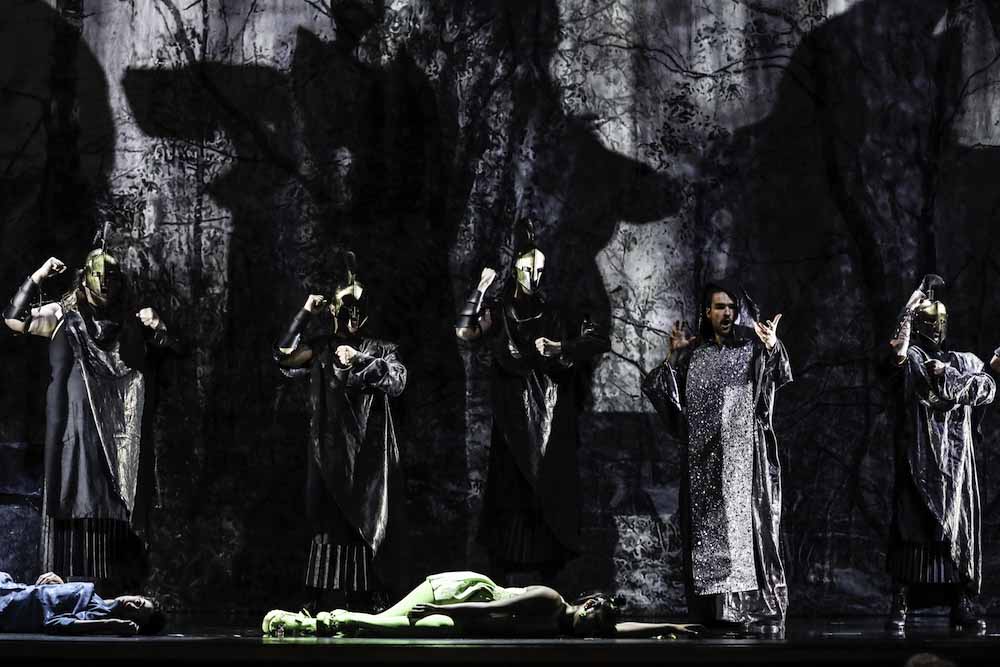Opera in the 21st century has been radicalized and reimagined by new artists and musical languages, but nothing quite prepared me for the fevered dream of …(Iphigenia), a new work based on Euripides’ tale of probable infanticide. Composer-musicians Wayne Shorter and esperanza spalding teamed up to disinter the bones of the myth and examine motivations of not just pater, King Agamemnon, but also daughter Iphigenia and women throughout history who, this creative team thinks, must share some culpability in accepting such as self-sacrifice.
There is more than a 50-year age difference between Wayne Shorter (88), considered the greatest living jazz composer, and Grammy Award–winning esperanza spalding, and they were working on opposite coasts for this collaboration. Nonetheless, they engendered a creation that is already the stuff of legends. It premiered last month in Boston and was performed this weekend at a packed Kennedy Center Eisenhower Theater.

The opera started out as an odd pastiche, even parody: Full Metal Jacket meets Monty Python. The guys are suited up for war on a barren landscape, the only stage element a large stone altar against a scrim with a red sky projection. The men are restless, edgy, and stuck in this windless landscape, unable to embark on their war against the Trojans. Two brothers — leaders Agamemnon and Menelaos with their long “rock star” hair — are the only ones whose faces we see clearly. Tenor Arnold Livingston Geis as Agamemnon and baritone Brad Walker as Menelaos have powerful vocal chops as does tenor Samuel White as the oracle/seer Kalchas. Kalchas crudely solves the Greeks’ dilemma caused by Agamemnon engendering the wrath of a goddess, by suggesting sacrificing the young girl to Artemis.
Enter Iphigenia, soprano Nivi Ravi, dressed as a spring-green flower child. She gets hoisted onto the altar, and in delicate slow motion, Dad slits his daughter’s throat. The men cheer, each one lifts a fisted arm into the air, then in single file they run-march in a double-time jody. These soldier buddies repeat the scene again. Enter another Iphigenia. And so on. It’s absurd, even pushing bloated opera-with-elephants conventions, and the toxic masculinity is no doubt intentionally unremarkable.
At one point the men get drunk. Soldiers become frat boys, as they stumble and throw jumbo-sized red plastic cups, littering the stage. One of the soldiers runs across the stage left to right carrying a flesh-colored plastic blow-up sex doll. Soldiers mill around grunting in a crocodile line and exit again.

Part II shifts to focus on the several Iphigenias. Each one is color-coded and each has her own sound terrain. Sopranos Alexandra Smither as Iphigenia of the Light and Joanna Lynn-Jacobs as Iphigenia of the Sea are followed by mezzo-soprano Kelly Guerra as Iphigenia Unbound. (Later, the same singer plays Opera Broadcast Host, trying overly hard at this point in the opera to make the work relevant.) Most distinct is the saffron-clothed, Iphigenia the elder. Sharmay Musacchio is an extraordinary contralto who pulls out the stops in terms of range and colors.
The stage space has opened up. Billowy baroque-like design elements by acclaimed architect-designer Frank Gehry are flown in. Clouds? They seem delicate in their light-catching translucency yet dangerous in their needle-like spikes.
One suddenly realizes that musically the creators have thrown away the rulebook. It’s not jazz exactly and certainly not what one has heard as classical contemporary. It has pushed boundaries between members of the creative team. (Caroline Shaw is given compositional credit for the female choral voices who form cluster chords, move into unison, then play with wide-wavering vibrato so that the whole effect is of voices becoming destabilized, each Iphigenia threatening to take over from another. Who’s in charge? Whether scored or improvisation, this feels like opera as incantation.
Meanwhile, Kennedy Center orchestra members in the pit led by conductor Clark Rundell, in charge of additional orchestrations and musical dramaturgy, mushrooms in polyrhythms and density.
Shorter has delivered his most seething and slippery of scores. It takes you by surprise, and I found myself lost at times in a musical labyrinth.

With something so ambitious, there are bound to be bloopers. The character Usher, played by Brenda Pressley, wanders through the proceedings. Elegantly dressed, she only speaks, a guide-interpreter of sorts, and periodically exhorts one of the six Iphigenias to break the spell and get out of this mess. But as she gets drowned out in the balance of sound (intentional?), I never understood her function.
There is no doubt that spalding is fearless. I was stunned to realize she was there in the mix of Iphigenias. She stood out not just because she was dressed in a silver 21st-century astronaut jumpsuit but when she moved into her own solo work, she went to places stylistically, perhaps even spiritually, no one in the ensemble had ventured. Humming, delving into resonant head and body spaces, this artist, like Shorter, broke all the rules. She didn’t hesitate to pare back sound and explore deep space.
In Part III the stage is stripped further to reveal the back walls, and there, stage right, a jazz trio became the focus. The audience reveled in drinking in three amazing jazz musicians — bassist John Patitucci, pianist Danilo Perez, and drummer Brian Blade, whom Shorter assembled back in 2000 for his quartet. For jazz lovers, these guys are kings. And what was the fit for the opera story?
So is Shorter still crazy after all these years? WTF. You bet.
Running Time: Approximately one hour 45 minutes, with no intermission.
…(Iphigenia) played December 10 and 11, 2021, in the Eisenhower Theater of the Kennedy Center, 2700 F Street, NW, Washington, DC.
The digital program can be viewed here.
For a full list of the Kennedy Center’s 50th anniversary season events, click here.
To learn more about the Kennedy Center’s 50th Anniversary, click here.




